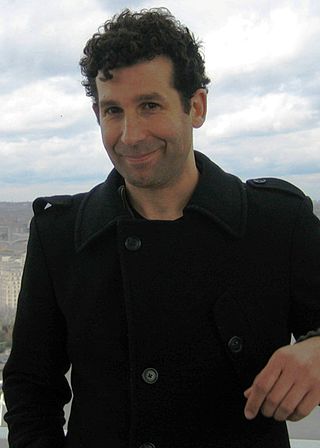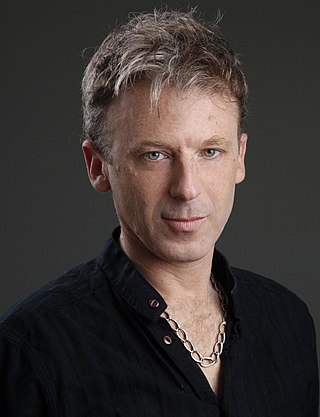Michael Gross was an Israeli painter, sculptor and conceptual artist.

Shimshon Holzman was an Israeli landscape and figurative painter. He is known worldwide for his water color paintings.

Fred Forest is a French new media artist making use of video, photography, the printed press, mail, radio, television, telephone, telematics, and the internet in a wide range of installations, performances, and public interventions that explore both the ramifications and potential of media space. He was a cofounder of both the Sociological Art Collective (1974) and the Aesthetics of Communication movement (1983).
Communication Aesthetics is a theory devised by Mario Costa and Fred Forest at Mercato San Severino in Italy in 1983. It is a theory of aesthetics calling for artistic practice engaging with and working through the developments, evolutions and paradigms of late twentieth century communications technologies. Observing the emerging supremacy of networks over subjects, it called for an artistic approach that was both adapted to, and invested in this changing techno-social arena.

Avraham Eilat is an Israeli artist, educator and curator. He graduated from the Hebrew Gimnasium Herzliya in Tel Aviv, and was enrolled in Hashomer Hatzair youth movement for nine years starting at age 9. After military service in 1960 he joined in Kibbutz Shamir, situated on the western slopes of the Golan Heights in the Upper Galilee, where he was a member until 1978. During his first years in the kibbutz, Eilat was a shepherd side-by-side with his kibbutz adopting father the painter Moshe Cagan. Close contact with nature and its phenomenon and the features of local landscape deeply influenced his way of thinking and established the themes appearing along all his career in his art. The contrast between man-made geometrical shapes of fish ponds and the free flowing of the flora and typical hilly landscape of the Hula Valley area, crystallized his visual language and determined its formal and thematic foundations. Avraham Eilat employs skillfully various means of expression: drawing and painting, etching, photography, sculpture, installation, and often a combination of more than one. Using those means enriches his basic statement and makes it complex and multi-layered. Avraham Eilat lives in Ein Hod Artists Village, Israel, with his spouse Margol Guttman, works in his studio in Pyramida Center of Contemporary Art, Wadi Salib, Haifa, and in his studio in Ein Hod.

Maurizio Bolognini is a post-conceptual media artist. His installations are mainly concerned with the aesthetics of machines, and are based on the minimal and abstract activation of technological processes that are beyond the artist's control, at the intersection of generative art, public art and e-democracy.

Mario Costa was an Italian philosopher. He was known for his studies of the consequences of new technology in art and aesthetics, which introduced a new theoretical perspective through concepts such as the "communication aesthetics", the "technological sublime", the "communication block", and the "aesthetics of flux".
Artmedia was one of the first scientific projects concerning the relationship between art, technology, philosophy and aesthetics. It was founded in 1985 at the University of Salerno. For over two decades, until 2009, dozens of projects, studies, exhibitions and conferences on new technologies made Artmedia a reference point for many internationally renowned scholars and artists, and contributed to the growing cultural interest in the aesthetics of media, the aesthetics of networks, and their ethical and anthropological implications.

Ruti Sela, is a video artist.

Shahar Marcus is an Israeli artist who works primarily in video, performance and installations.

Visual arts in Israel or Israeli art refers to visual art or plastic art created by Israeli artists or Jewish painters in the Yishuv. Visual art in Israel encompasses a wide spectrum of techniques, styles and themes reflecting a dialogue with Jewish art throughout the ages and attempts to formulate a national identity.

Israeli sculpture designates sculpture produced in the Land of Israel from 1906, the year the "Bezalel School of Arts and Crafts" was established. The process of crystallization of Israeli sculpture was influenced at every stage by international sculpture. In the early period of Israeli sculpture, most of its important sculptors were immigrants to the Land of Israel, and their art was a synthesis of the influence of European sculpture with the way in which the national artistic identity developed in the Land of Israel and later in the State of Israel.

Genia Berger (1907–2000) was an Israeli artist, born in the Russian Empire.
Nira Pereg is a visual artist. She was born in Tel Aviv. She lived in Jerusalem for a short time, where she graduated with an MFA from Bezalel Academy of Arts and Design. She is an Associate Professor of Art at Shenkar College.
Michael Druks was an Israeli-born British artist.

Daniel Landau is an Israeli entrepreneur, artist, and researcher. He has presented his work on virtual reality at museums, festivals, and conferences worldwide.
Nona Orbach is an Israeli multidisciplinary artist, art therapist and teacher.
Hannan Abu-Hussein is a Palestinian visual artist and educator. She is known for installation art and video art. Abu-Hussein lives in Jerusalem.

Miri Segal is a new media artist currently living in Tel Aviv. Segal was born 1965, in Haifa, Israel. Since the late 90s she has created video and media installations, light objects and theatrical pieces. Prior to her career as an artist she studied Mathematics. In 1997, She received a PhD in mathematics from the Hebrew University in Jerusalem under the instruction of Prof. Menachem Magidor. In 1998, she studied Art at the San Francisco Art Institute. Segal owes her taste for the mechanisms of perception and the construction of sense-stimulating illusions to her mathematical background, according to art historian Hanna Almeka.

Lilah Markman is an Israeli contemporary artist, sculptor, photographer, painter, and documentary film director.













